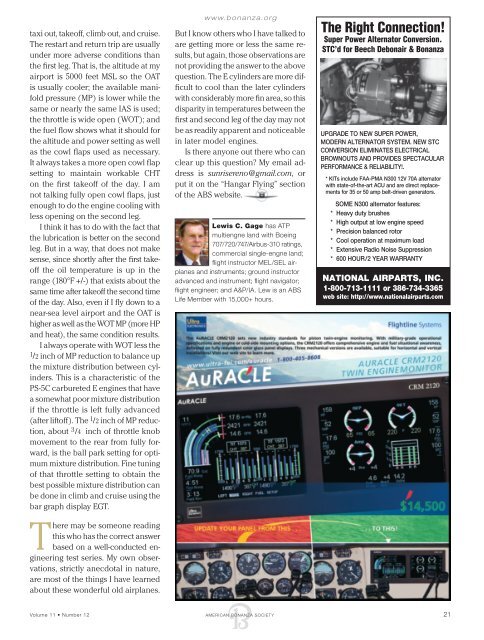december 2011 volume 11 ⢠number 12 - American Bonanza Society
december 2011 volume 11 ⢠number 12 - American Bonanza Society
december 2011 volume 11 ⢠number 12 - American Bonanza Society
You also want an ePaper? Increase the reach of your titles
YUMPU automatically turns print PDFs into web optimized ePapers that Google loves.
taxi out, takeoff, climb out, and cruise.The restart and return trip are usuallyunder more adverse conditions thanthe first leg. That is, the altitude at myairport is 5000 feet MSL so the OATis usually cooler; the available manifoldpressure (MP) is lower while thesame or nearly the same IAS is used;the throttle is wide open (WOT); andthe fuel flow shows what it should forthe altitude and power setting as wellas the cowl flaps used as necessary.It always takes a more open cowl flapsetting to maintain workable CHTon the first takeoff of the day. I amnot talking fully open cowl flaps, justenough to do the engine cooling withless opening on the second leg.I think it has to do with the fact thatthe lubrication is better on the secondleg. But in a way, that does not makesense, since shortly after the first takeoffthe oil temperature is up in therange (180°F +/-) that exists about thesame time after takeoff the second timeof the day. Also, even if I fly down to anear-sea level airport and the OAT ishigher as well as the WOT MP (more HPand heat), the same condition results.I always operate with WOT less the1 /2 inch of MP reduction to balance upthe mixture distribution between cylinders.This is a characteristic of thePS-5C carbureted E engines that havea somewhat poor mixture distributionif the throttle is left fully advanced(after liftoff). The 1 /2 inch of MP reduction,about 3 /4 inch of throttle knobmovement to the rear from fully forward,is the ball park setting for optimummixture distri bution. Fine tuningof that throttle setting to obtain thebest possible mixture distribution canbe done in climb and cruise using thebar graph display EGT.There may be someone readingthis who has the correct answerbased on a well-conducted engineeringtest series. My own observations,strictly anecdotal in nature,are most of the things I have learnedabout these wonderful old airplanes.www.bonanza.orgBut I know others who I have talked toare getting more or less the same results,but again, those observations arenot providing the answer to the abovequestion. The E cylinders are more difficultto cool than the later cylinderswith considerably more fin area, so thisdisparity in temperatures between thefirst and second leg of the day may notbe as readily apparent and noticeablein later model engines.Is there anyone out there who canclear up this question? My email addressis sunrisereno@gmail.com, orput it on the “Hangar Flying” sectionof the ABS website.Lewis C. Gage has ATPmultiengne land with Boeing707/720/747/Airbus-310 ratings,commercial single-engne land;flight instructor MEL/SEL air -planes and instruments; ground instructoradvanced and instrument; flight navigator;flight engineer; and A&P/IA. Lew is an ABSLife Member with 15,000+ hours.The Right Connection!Super Power Alternator Conversion.STC’d for Beech Debonair & <strong>Bonanza</strong>UPGRADE TO NEW SUPER POWER,MODERN ALTERNATOR SYSTEM. NEW STCCONVERSION ELIMINATES ELECTRICALBROWNOUTS AND PROVIDES SPECTACULARPERFORMANCE & RELIABILITY!.* KITs include FAA-PMA N300 <strong>12</strong>V 70A alternatorwith state-of-the-art ACU and are direct replacementsfor 35 or 50 amp belt-driven generators.SOME N300 alternator features:* Heavy duty brushes* High output at low engine speed* Precision balanced rotor* Cool operation at maximum load* Extensive Radio Noise Suppression* 600 HOUR/2 YEAR WARRANTYNATIONAL AIRPARTS, INC.1-800-713-<strong>11</strong><strong>11</strong> or 386-734-3365web site: http://www.nationalairparts.comVolume <strong>11</strong> • Number <strong>12</strong> AMERICAN BONANZA SOCIETY 21

















